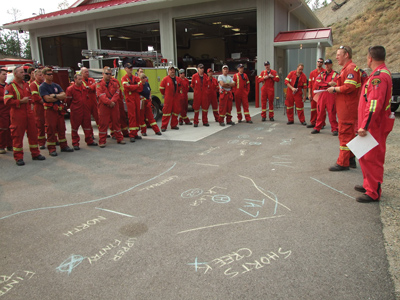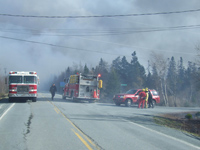
Features
Emergency & disaster management
Hot topics
Be prepared
One aspect of incident command system training that is often overlooked is staging and base camps to support large-scale events. Large-scale events may not occur often in a career but it’s prudent for chiefs and officers to discuss the what ifs.
June 4, 2010
By Lou Wilde
One aspect of incident command system training that is often overlooked is staging and base camps to support large-scale events. Large-scale events may not occur often in a career but it’s prudent for chiefs and officers to discuss the what ifs.
 |
|
| Darren Lee from West Kelowna and Kelowna Assistant Chief Lou Wilde (right) brief crews during the Terrace Mountain fire in August 2009. Photo courtesy Kelowna Fire Department |
Here’s an example: In August 2003 when a lightning strike in Okanagan Provincial Park became a threat to the city of Kelowna, B.C., mutual aid was requested and received from as far away as the Edmonton (Alberta) Fire Department. Within 24 hours of the request for mutual aid during the provincial state of emergency, we had 62 additional companies and more than 250 staff.
The road in front of our main station had to be closed; lineups had to be drafted for day and night shifts; personnel had to be tracked for accountability and for pay. Supplies from hoses to Gatorade needed to be available and monitored. It should have taken an army of people to support the army in the field. In Kelowna, we are working on a system to set up a large-scale base camp so that when an incident of this magnitude happens again we will have a template and be better prepared for 250 additional staff.
Here are some of the basics that need to be managed in a base camp.
- Stores: firefighting supplies, water, Gatorade, power bars and other items need to be kept secure and issued by staff rather than having a “free for all.”
- Finance section chief: you need to set up an F and A section before people arrive, if possible, so that pay for members can be accounted for along with invoicing for all that Gatorade.
- Radio frequencies: If companies are showing up with radios that do not have proper frequencies, then a radio company should be contracted to provide reprogramming on their arrival. If members have to be issued radios, you need an accountability system to track of who has radios and who has returned them. Batteries need to be charged and a method must be developed to ensure members aren’t going out to the field with a battery that will soon die.
- Personnel accountability: If your local departments use the same system with a tag on a ring or Velcro, that may be OK, but what if you have private contractors or police or ambulance or anyone else who doesn’t use your fire department’s system to track names and assignments?
- What happens if people show up and don’t have proper personal protective equipment?
- Lost and found: This is necessary so people have a place to deposit or look for items instead of asking. This seems simple but is necessary, as is a message board through which people can contact each other. This kind of thing can be made available at a kiosk in a central spot where people can go for information rather relying on someone to tell them.
- A kiosk is also a good place to post official messages or notices such as lineups, directions and maps.
In 2003, during the Okanagan Park fire, we had a number of unsolicited donations, from extinguishing agent to socks and everything in between. We had to control the receiving and disbursement of all this stuff. Businesses and members of the public want to help. They give what they can and, although it’s appreciated, we have to be careful about how we use it – from a kind-hearted elderly woman bringing in pies that shouldn’t be eaten (ask your local food safe people about this) to the company that “donates” equipment then invoices your department or uses the acceptance of the donation as your endorsement in later advertising. Don’t get me wrong – tons of good corporate and private citizens made a huge difference through their support in the work we were able to do – it’s just something you have to be aware of.
 |
|
| Staging areas and preparation are key to managing large-scale incidents. Photo courtesy Halifax Regional Fire & Emergency Services/John Giggey |
Rehab for personnel is crucial. Members should arrive at camp early enough to go through the so-called “meat grinder” – where they enter in to F and A, go to accountability for assignment, receive assignments, maps and documents and sign out equipment, go through rehab for vitals and are briefed on the upcoming operational period before going into service. This should all be done prior to the swap out for the off coming shift. This takes a lot of co-ordination and may involve busing members to the field or having apparatus pack up and return to base camp.
Smaller, rural departments may have the added challenge of getting supplies due to their remote locations. Fuel tankers may have to be ordered and parked on site. A canteen or cook shack and mess hall may have to be assembled to feed people. Tents may come from the local militia or party rental store. Washroom facilities should be planned for if the fire hall is on a septic system. All departments should ask how they would manage two or three times or 10 times the staff they currently have. Talk to your neighbouring departments to see how you can work together.
The next thing to prepare is a mobile staging kit to set up in the field for members from multiple jurisdictions and agencies. Are you able to do all this from your vehicle in a parking lot? Recently, I helped to operate a base camp/staging area for 20 apparatus, two paramedic teams and almost 80 firefighters out of a two-bay fire station. Lessons on preparation for managing that many members from various departments and briefing them on the upcoming operation period were reinforced. You need to have the simple things, like clipboards and paper, duct tape and a step-by-step direction chart for processing people through the meat grinder. Briefings may be held for select members such as division supervisors and task force leaders or for all members. All pertinent information must be made available to the members so they are best prepared for the operational period. A T-card system, similar to the one that the forest service in B.C. uses, is ideal. The British Columbia Forest Service has its act together when it comes to operating at these lengthy events. Indeed, it was the US Forest Service that was called in to New York during 9-11 to help FDNY and NYPD operate an incident of that size for the duration of the search and clean up.
A lot of times during large events it makes sense to use your local members to fill roles of base camp manager, command staff and section chiefs. It is imperative to have people with local knowledge in key roles even to the point of using your local members as escorts so that out-of-town companies have local knowledge on each apparatus if necessary. Use the imported help to do the grunt work and your local people where they can do the most good. Smaller departments that have little experience running larger operations should not be afraid to call for help. Get help from those who have experience to help run the incident command or operations section – it will be some of the best on the job training you’ve ever had. The B.C. forest service has Type 1 command teams that travel when and where needed. Maybe the provincial fire commissioner’s office can spearhead a similar program that would be of great benefit, especially to the small rural departments that encounter their once-in-a-lifetime career incident.
It’s one thing to know incident command and how to run a regular, everyday emergency but what if you had 10 times the number of staff on their way to you right now? Ask yourself some of the what ifs posed here. As we all know, there’s nothing like being prepared.
Lou Wilde is the assistant chief in Kelowna, B.C.
Print this page